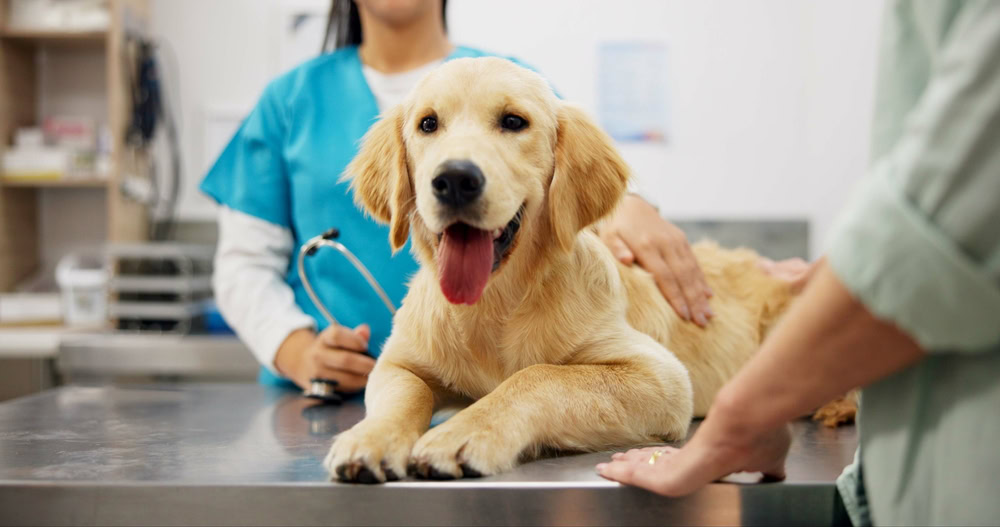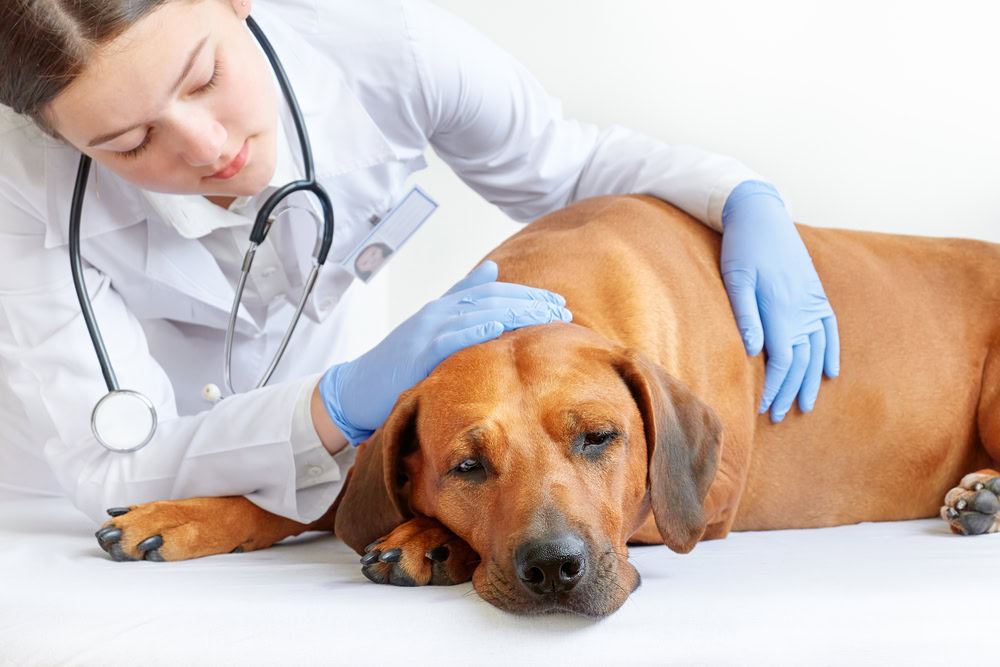VET APPROVED

The information is current and up-to-date in accordance with the latest veterinarian research.
Learn more »Click to Skip Ahead
PLEASE NOTE: We recommend speaking with a vet before administering any form of medication to your pet. The doses of human medication are not appropriate for dogs. The information provided in this article is for informational purposes only, and should not replace the advice of your veterinarian.
When our pets are ill or in distress, it’s natural for us to want to reach for something we already have at home. And while some human medications are safe for our pets, some can be harmful, even deadly. If you are looking for something to give your dog, the best thing to do is speak to your vet, as they will be able to advise you based on your specific situation.
Benadryl is one medication in our drug cabinet that can be given to dogs, but it’s imperative to know how, why, and how much of this medication can be given, or it can cause more problems than it solves.
For our canine companions, Benadryl can be useful for treating mild allergies, anxiety, and travel sickness. Just like with any medication, there are some potential side effects to be aware of, as well as circumstances in which it should not be given. Read on to find out how Benadryl works on dogs, when it can be given, and the appropriate doses for your dog.
What Is Benadryl?
Benadryl is the most common brand name for the drug Diphenhydramine hydrochloride, an H1 (histamine-1) antagonist that blocks the action of histamine, alleviating allergic reactions such as pruritus (itching), redness, and urticaria (skin rash). In humans, it is also used to treat vertigo and motion sickness. One of the most common side effects of diphenhydramine is drowsiness, but this is often seen as an advantage when treating certain conditions, such as vaccine reactions or severe pruritus.
Oral Benadryl comes in a variety of forms, including tablets, gel capsules, chewable tablets, and oral liquids.

When Can I Use Benadryl For My Dog?
There are three main reasons we might want to use Benadryl in dogs: pruritus/allergies, anti-nausea, and sedation.
Benadryl for Skin
Histamine plays a major role in human allergy pathways but is not very significant in canine inflammation, so Benadryl is less effective in treating allergic reactions in dogs. However, it is believed to have a synergistic effect with Omega-3 fatty acids, so the use of the two together can be an effective tool in managing allergic skin disease or atopy. It can also be used to reduce the side effects of vaccines.
For dogs that have been diagnosed with mast cell tumors, antihistamines are often used alongside surgery or other treatments to reduce their inflammation and spread.
Benadryl for Nausea
Benadryl is not appropriate for dogs experiencing more severe forms of vomiting and nausea. However, it can help reduce mild nausea, particularly for dogs that experience travel sickness, with the additional benefit of helping them feel more settled.

Benadryl for Anxiety
As mentioned above, Benadryl is particularly useful for dogs that suffer from nausea and anxiety when traveling in cars. Quite often, the stress exhibited by dogs in cars is due to the nausea they are experiencing, even though they may not actually vomit, so Benadryl can be quite helpful in making a long car journey more pleasant for your dog, and everyone else in the vehicle!
Benadryl is not overly effective for dogs that suffer from more chronic forms of anxiety or severe reactions to loud noises like thunderstorms and fireworks, so you should speak to your vet about alternatives if your dog needs more regular anxiety treatment.
Some dogs may become a little sleepy on Benadryl, others may be quite sedated, and for some dogs, Benadryl can have the opposite effect, resulting in agitation, hypervigilance, and even aggression. This medication is not recommended for short car journeys as the drowsiness effects can sometimes last up to 8 hours.
If you are thinking about trying Benadryl for a car journey, we recommend giving a trial dose a few days beforehand to assess their response.
What Is The Dose of Benadryl for Dogs?
You should always check with your vet to make sure you are using the correct dose of Benadryl for your pet, as factors like age, breed, health, and other medications will affect the dose your dog will need.
The dose range of Benadryl for dogs is 2-4 mg/kg (0.9-1.8 mg/lb) every 8-12 hours as needed (2-3 times per 24 hours). Always start with the lower dose, and increase only if necessary. Liquid capsules cannot be divided, so are not recommended for dogs. The children’s formulations are ideal for small dogs, but less feasible for large dogs.
These doses are a guide only. Consult your vet before using these products on your pet.

| Dog Weight (lbs) | Benadryl | |||
| 25 mg tablets | 50mg tablets | Children’s liquid
12.5 mg/5ml |
12.5 mg chewable tablets | |
| 5 | X | X | 1.8 to 3.6 ml | ¼ to ½ |
| 10 | ¼ to ½ | X | 3.6 to 7.2 ml | ¾ to 1 ½ |
| 15 | ½ to 1 | ¼ to ½ | 5.4 to 10.8 ml | 1 to 2 |
| 20 | ¾ to 1 ½ | ¼ to ¾ | 7.2 to 14.4 ml | 1 ½ to 2 ¾ |
| 30 | 1 to 2 | ½ to 1 | 10.8 to 21.6 ml | 2 to 4 |
| 40 | 1 ¼ to 2 ¾ | ¾ to 1 ½ | 14.4 to 28.8 ml | 3 to 5 ¾ |
| 50 | 1 ¾ to 3 ½ | 1 to 1 ¾ | 18 to 36 ml | 3 ½ to 7 |
| 60 | 2 to 4 | 1 to 2 | 21.6 to 42.6 ml | 4 to 8 ½ |
| 70 | 2.5 to 5 | 1 ¼ to 2 ½ | 25.2 to 50.4 ml | 5 to 10 |
| 80 | 3 to 5 ¾ | 1 ½ to 2 ¾ | 28.8 to 57.6 ml | 5 ¾ to 11 ½ |
| 90 | 3 ¼ to 6 ½ | 1 ½ to 3 | 32.4 to 64.8 ml | 6 ½ to 13 |
| 100 | 3 ½ to 7 | 1 ¾ to 3 ½ | 36 to 72 ml | 7 to 14 |
What Are The Potential Side Effects of Benadryl?
Some of the listed side effects of Benadryl are actually the desired effects (eg. drowsiness). There are few other notable side effects of Benadryl in dogs, but it has been known to cause dry mouth, constipation, and difficulty urinating in humans. A 2016 study of diphenhydramine toxicosis in dogs recorded the following clinical signs in dogs that had been exposed to high doses of the drug:
- Lethargy
- Hyperactivity or agitation
- Tachycardia
- Ataxia (unsteadiness)
- Hyperthermia (high temperature)
- Tremors/twitching
- Vocalization
- Hyperesthesia (increased sensitivity to touch/pain)
- Vomiting
- Seizures
- Hypertension (high blood pressure)
In the majority of cases, moderate to severe signs of toxicosis were only seen in dogs that had ingested more than ten times the recommended dose.

Can I Use Other Forms of Benadryl On My Dog?
Topical preparations (sprays, ointments, and gels) contain zinc, which can be toxic to dogs. As the safety of these products has not been established, we do not recommend using them on pets.
There are also formulations of Benadryl for sinus headaches or congestion. These contain ingredients that are not safe for dogs. Only Benadryl Allergy, containing diphenhydramine, should be used with dogs.
When Is Benadryl Not Safe?
Although it is a relatively safe medication, any overdoses should be referred to your veterinarian or poisons hotline immediately. Its use should also be avoided (unless specifically recommended by your vet) in dogs with the following conditions:
- Heart disease
- Some respiratory conditions
- Liver disease
- Seizure disorders
- Glaucoma
It should not be used in pregnant or lactating females, or in conjunction with certain medications, including some used to treat vomiting and gut motility issues (metoclopramide), cognitive dysfunction (selegiline), and anxiety (clomipramine).

Final Thoughts
It’s never a good idea to give your dog human medications without checking with your vet first. Even those that are considered to be safe for dogs, like Benadryl, may not always be appropriate for every individual or situation. Additionally, medications that are safe for dogs often are not safe for cats, so you should always consult with your vet first.
For dogs with a clean bill of health, Benadryl (Diphenhydramine) can be helpful in certain situations, most notably for dogs that suffer from travel sickness and anxiety. It can be useful for pre-medicating dogs that are sensitive to vaccines and can take the edge off itchy skin. However, it is not the most effective option when it comes to managing chronic skin disease, allergy, or atopy in dogs, so it’s best to stick to what your vet recommends in these cases.
Pet Poisons Contacts
- Pet Poison Helpline
- ASPCA Animal Poison Control
- Veterinary Poisons Information Service
- Animal Poison Line UK
Featured Image Credit: EHStockphoto, Shutterstock













